
You’re in charge of spraying on your farm. If solids form and the tank, lines and nozzles must be cleaned out, you’re the person responsible. If you’re not the person who sprays and something goes wrong, you’ll likely get a call for help. Either way, gunk in a sprayer becomes your problem, too. The “lucky one” will get to clean the mess from the nozzles!
“You can prevent many issues by testing spray mixtures in jar tests before you mix them together in the tank,” says Fred Whitford, Purdue University Pesticide Programs director. “What you’re looking for is physical incompatibility between products.”
Whtiford’s reasoning is simple. It’s better to have a problem with a pint of material than with hundreds of gallons in a sprayer tank. Dealing with the first is a nuisance. Dealing with the second is a costly nightmare.
Why a jar test
A jar test involves obtaining a relatively inexpensive test kit with a pipette and testing bottles, and following simple instructions, Whitford says. In the publication Avoid Tank Mixing Errors, PPP-122, Whitford describes how to use the Precision Laboratories Compatibility Test Kit. Learn more about it at precisionlab.com. This is not an endorsement; other kits are available. This is simply the one Whitford used as an example.
What you’re looking for is possible physical incompatibility between products, Whitford says. With this kit, 100 milliliters of product represent 100 gallons of spray solution. The mixing container is calibrated based on how many acres 100 gallons of spray mix will cover.
To conduct the test properly, add each product, invert the test container for proper mixing, and wait 30 minutes for signs of physical incompatibility. The best option is to let the final mixture sit overnight.
What kind of physical incompatibility problems could you see? Here are a few:
Spray mixture is not uniform, as noted in the bottle or jar.
Material settles to the bottom unusually fast after being added to the mixture.
Particles float on the surface of the solution.
Residues accumulate on the sides of the container.
Large particles are obvious — too large to pass through screens, filters or spray nozzles.
Realistic test
If you’re using fertilizer as the carrier instead of water, a jar test becomes even more critical, Whitford says. Some products can cause issues in a fertilizer mixture when they might not if water were the carrier.
If you’re using water as a carrier, a jar test is still a good idea. It becomes an even smarter idea if you’re mixing more than two types of products, including pesticides, adjuvants, micronutrients and fertilizers in water.
Even if you’re making a familiar tankmix you’ve made in previous years, Whitford still recommends doing a jar test first.
“Companies can change inert ingredients in the formulation from one year to the next,” he explains. Just a slight change in inert ingredients, although the active ingredient is still the same, could cause potential compatibility issues.
Use the same water source when you conduct the jar test that you will use to fill the spray tank, Whitford notes. And make sure water temperature for the jar test and actual mixing is the same.
About the Author(s)
You May Also Like




